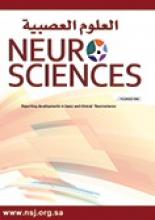Abstract
OBJECTIVE: To examine the feasibility and efficacy of a modified constraint induced therapy protocol on stroke patients.
METHODS: This study was carried out during the period from August 2001 to January 2002 at the Riyadh Medical Complex, Riyadh, Kingdom of Saudi Arabia. Six stroke patients with subacute cerebrovascular accident (<6 months) were included in the study. Three male and 3 female patients with a mean age of 54.3+/-6.9 years (range 45-67 years), and mean duration of hemiparesis of 4.7 months (range 2.3-5.8 months). They were divided randomly into 3 groups of 2 patients. The first 2 patients (constraint induced therapy group) participated in half an hour of physical and occupational therapy sessions 3 times per week for 10 weeks. During the same period, their unaffected arms and hands were restrained 5 days per week for 5 hours identified as times of frequent use. The second 2 patients (traditional therapy group) received regular therapy administered after 10 weeks. The last 2 patients (control group) received no therapy. The Fugl-Meyer Assessment of Motor Recovery After Stroke (Fugl), Action Research Arm Test (ARA), Wolf Motor Function Test (WMFT), and Motor Activity Log (MAL) were administered to the patients.
RESULTS: Patients receiving modified constraint induced therapy exhibited substantial improvement on the Fugl, ARA, and WMFT, as well as increases in amount and quality of use of the limb using the MAL. While patients receiving traditional physical and occupational therapy, and no therapy patients exhibited few improvements.
CONCLUSION: Modified constraint induced therapy may be an efficacious method of improving function and use of the affected arms in stroke patients exhibiting learned nonuse.
- Copyright: © Neurosciences
Neurosciences is an Open Access journal and articles published are distributed under the terms of the Creative Commons Attribution-NonCommercial License (CC BY-NC). Readers may copy, distribute, and display the work for non-commercial purposes with the proper citation of the original work.






